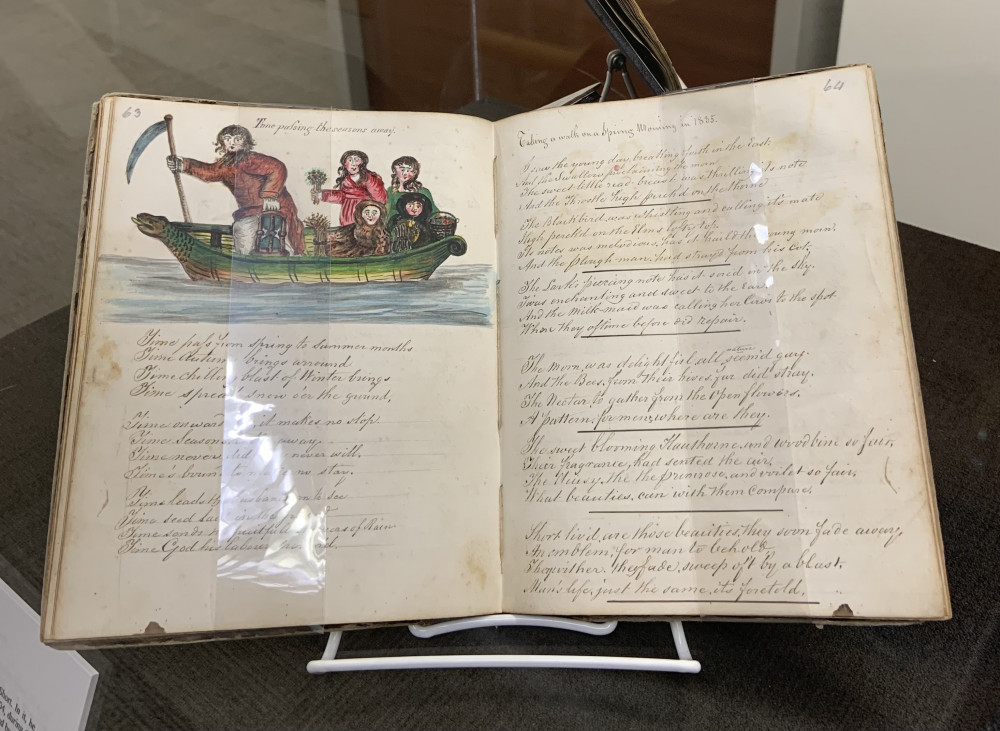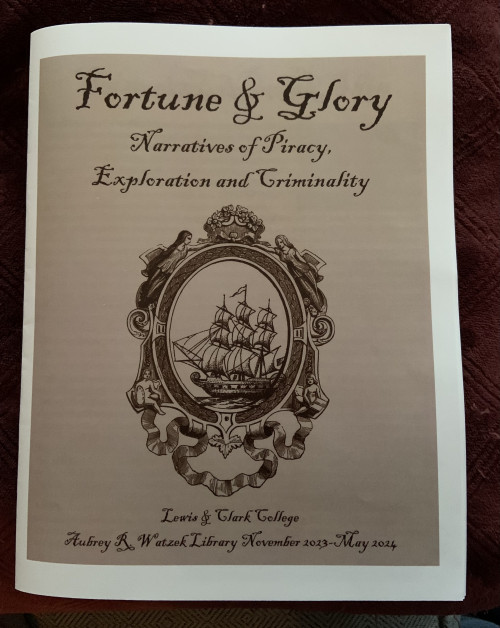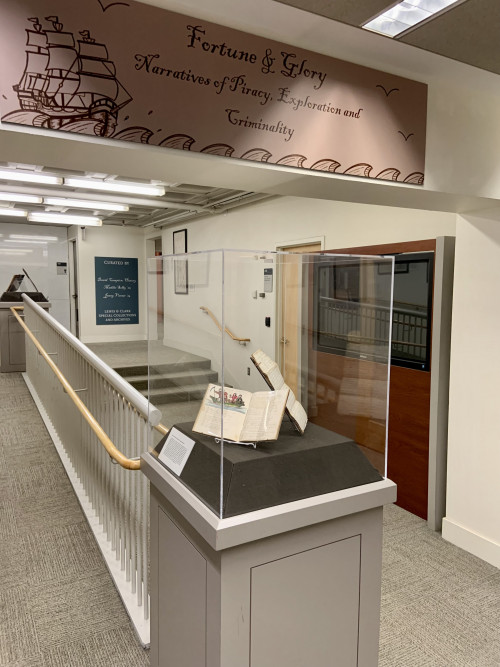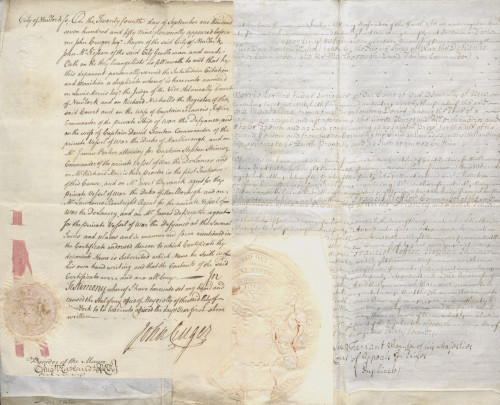New Exhibition Focuses on Narratives of Piracy, Exploration, and Criminality
Fortune and Glory, a collaborative faculty-student history exhibition, is on display in Watzek Library from now until March 2024.

Interviews by Mackenzie Kier BA ’26
Have you ever seen a real-life pirate’s log? How about a sailor’s handwritten journal from the 18th century? These are just a few of the objects in Lewis & Clark’s newest exhibition, Fortune and Glory: Narratives of Piracy, Exploration, and Criminality, on display in Watzek Library from now until March 2024.
Drawing from the diverse holdings of L&C’s Special Collections, Fortune and Glory considers cultures of European expansion from the 18th and 19th centuries, focusing on the confluence of criminality and exploration. Including a diverse array of material, from ships logs detailing British East India Company voyages, gallows letters from convicted pirates, litigation that led to a thriving privateering industry in colonial Manhattan, and a collection of maps promoting African exploration, this exhibit offers the L&C community and the general public a unique opportunity to view some of the rarest materials held at Watzek Library.
The exhibition is curated by David Campion, Pamplin Associate Professor of History; Maddie Selby BA ’25; and Jenny Varner BA ’24.
Exhibition Origins
Over the course of many years, Watzek’s Library’s Special Collections staff has acquired items that would be of scholarly interest to students and faculty.
“When considering a new item for our collections, we make sure it is a good fit for the subjects that are taught at Lewis & Clark,” says Hannah Crummé, head of special collections and college archives. “Often, these are items that complement our history and literature offerings.”
Professor Campion, who teaches courses on the British Empire and 18th- and 19th-century Britain, frequently uses items from Special Collections in his classes.
“I’ve actually taken students into our collections over the years, and I’ve had them look through some of these documents. I’ve used them quite a bit,” says Campion. “Some of them have to do with piracy. And others are government records, shipping manifests … things like that.”
- David Campion More about David
The liberal arts literally refers to freedom. It is a way of learning that never ends and in which the sum is greater than its parts.
He adds that some of the items are actually quite personal. “There are letters of convicted sailors or soldiers who are about to face execution, as well as handwritten journals, many of which describe what the authors are seeing on their various voyages.”
Campion felt these items should be shared more broadly, so the idea of a public exhibition in Watzek Library was born.
A Trio of Researchers
Professor Campion asked two of his former students, Selby and Varner, to collaborate with him on the exhibition. Both had taken his Historical Materials course, which had prepared them for the task at hand.
“I’ve taken multiple classes with Professor Campion, and he’s also my academic advisor, so I imagine he’s seen a lot of my growth as a college student,” says Selby. “Historical Materials teaches students about the discipline of history and is rather rigorous—for example, I wrote a 100-page annotation project for this class. It definitely prepares you for future historical research!”
- Maddie Selby BA ’25
I believe my summer research with Professor Campion gave me greater insight into what career options may look like for me as a history student.
History | Religious Studies | Portland, OregonMore about Maddie
Together, Campion and his students brainstormed themes that would allow them to present the selected collections items while giving them appropriate context. They hit on the themes of piracy, colonialism, exploration, and discovery.
“It was so fun to create a narrative with a wide variety of items that don’t look related at first glance,” says Selby.
The three-person team divided the work evenly. Varner primarily worked on the English and Dutch maritime collections and the novels in the collection. Selby worked on the designs for the exhibition banner and panels and also researched several items. Campion focused his research on the European explorers of Africa and the maps within the collection.
“We tried to weave a narrative that would fit with these themes and encompass all of these objects,” says Campion. “Some of the pieces are as recent as the early 20th century, and others date back all the way to the 17th century—all from different parts of the world.”
-
 Fortune and Glory exhibit program cover
Fortune and Glory exhibit program cover -
 The entryway to Fortune and Glory, a temporary exhibition on display through March 2024 in Watzek Library.
The entryway to Fortune and Glory, a temporary exhibition on display through March 2024 in Watzek Library. -
 The exhibition includes a collection of maps and books promoting African exploration.
The exhibition includes a collection of maps and books promoting African exploration. -
 These materials document court proceedings relating to the seizure of a Dutch ship by privateers (1759).
These materials document court proceedings relating to the seizure of a Dutch ship by privateers (1759).
Criminals, Pirates, and Explorers
One of the themes the team developed was the notion of criminality, both in terms of real people and fictional characters. They found the pirate logs in Special Collections to be especially rich in content.
In many cases, acts of piracy were considered either criminal or legal based on who was doing them. If these acts were sanctioned by a particular government, they would not have been considered criminal, “even if pirates were doing essentially the same thing,” explains Campion.
Another topic addressed in the exhibition is the Atlantic slave trade. “It was considered perfectly legal … something that today would be considered a crime against humanity under international law,” says Campion. “A lot of the big industries of the time—sugar, tobacco, and cotton—were all made possible by the enslaved labor of people in the West Indies and North America. This practice was not only considered legal and very profitable, but also the mechanism for building up the power of a lot of countries … Great Britain, in particular.”
One of the exhibition’s rarest items is a handwritten and hand-illustrated journal of someone aboard the East India Company ship, the Duke of Grafton. It was a ship that sailed from Britain to India via the southern tip of Africa. Aidan Bennett BA ’21, one of Campion’s past students, did his thesis research on the journal. Bennett thinks the author was the ship’s surgeon, just because of the author’s knowledge about science and natural history, but we don’t know for certain. “It’s almost like a ship’s log,” says Campion. “It shows the coordinates of places and even some illustrations of the landscape. I think that’s one of the most interesting pieces in the exhibition because you’re not going to see that anywhere else.”
Looking to the Future
When the physical exhibition closes, the plan is to launch a permanent digital exhibition on the Special Collections website.
“The digital exhibition will include a lot of the material that we’ve researched, including the items we cataloged that didn’t make it into the exhibition,” says Campion. “These materials will become a permanent part of the digital archives and Special Collections so that people can access them for the foreseeable future.”
The exhibition will also have a lasting impact on the students who worked on it.
“I hope to continue to study history after undergrad and this experience has shown me some of the possibilities of work I can do with my degree,” says Selby. “While I wouldn’t say it’s my ultimate goal of my history degree, I’d love to work in a museum and curate historical exhibits in the future. The curation of this exhibit is definitely one of the most fun and beneficial experiences I’ve had at Lewis & Clark.”
More Newsroom Stories
Public Relations is located in McAfee on the Undergraduate Campus.
MSC: 19
email public@lclark.edu
voice 503-768-7970
Public Relations
Lewis & Clark
615 S. Palatine Hill Road MSC 19
Portland OR 97219



